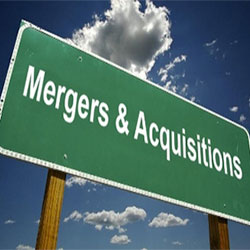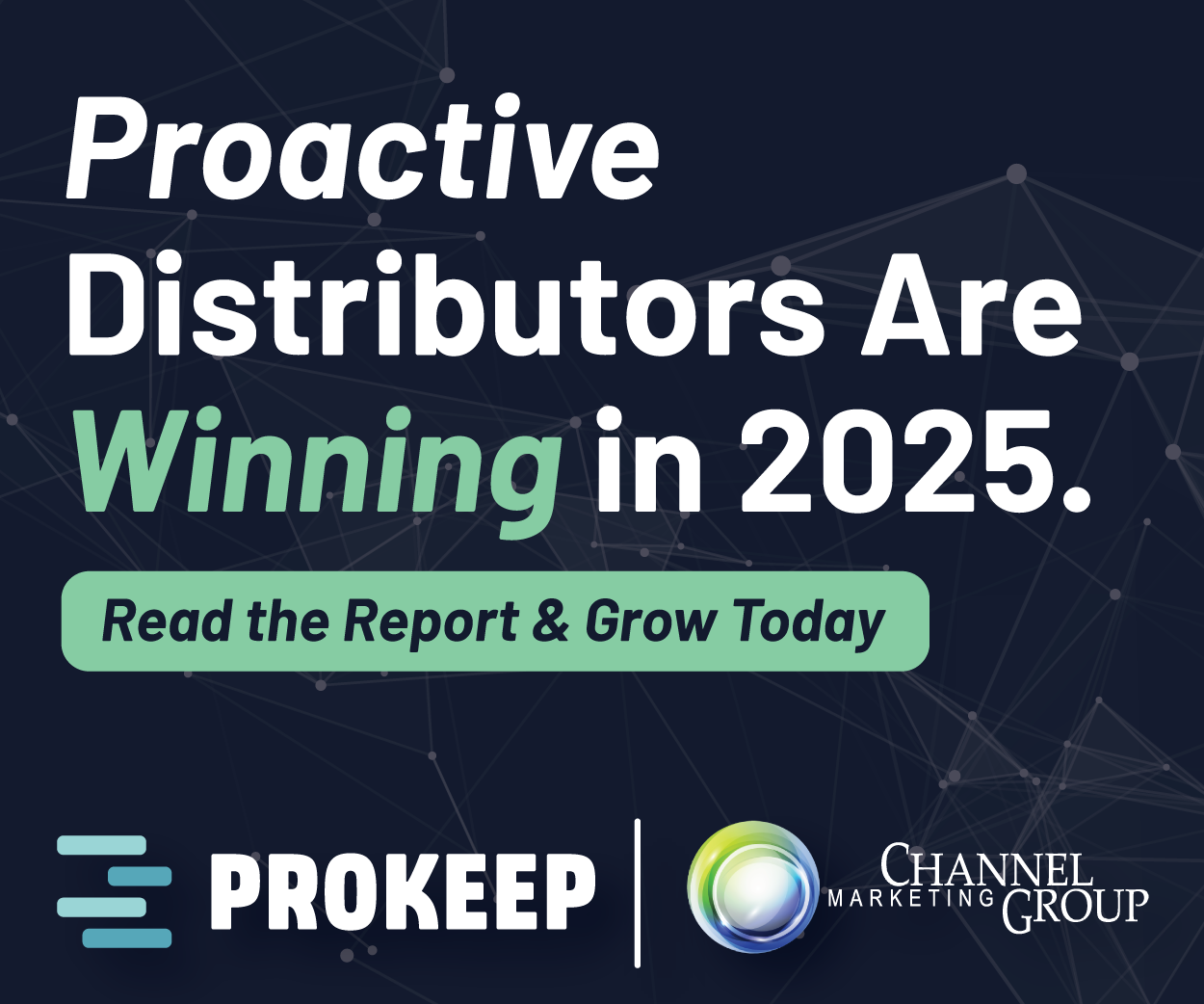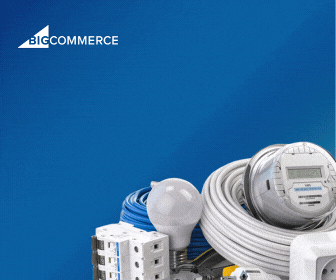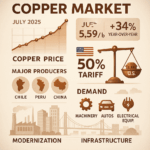Copper. Tariff Shocked. $6. Impact
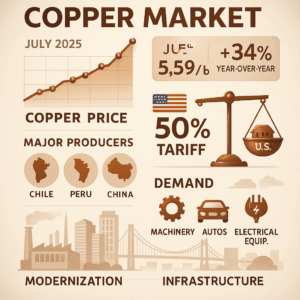 Copper has been in the headlines, for the electrical industry, much this year. Pricing has been like a roller coaster and now the number 6 is closer than ever before. Some will remember when it was less than a dollar. $3 and $4 were shocks. The forecast of $5 copper by S&P was viewed as “well into the future.” It’s now here and it would surprise many to see $6 very shortly. Year end?
Copper has been in the headlines, for the electrical industry, much this year. Pricing has been like a roller coaster and now the number 6 is closer than ever before. Some will remember when it was less than a dollar. $3 and $4 were shocks. The forecast of $5 copper by S&P was viewed as “well into the future.” It’s now here and it would surprise many to see $6 very shortly. Year end?
Consider the past 30 days. 
One thing that the pricing has done is increase the visibility of copper. More people are understanding the role it plays in everyday life and the broader economy.
Chris Sokoll, president of DISC, who also spent much of his career in the wire industry, shared insights on what is happening, and its impact.
“The Copper Crunch: How Tariffs Are Shocking the U.S. Electrical Industry
If you’re in the electrical distribution world, you’ve probably felt the tremors coming from the copper market lately. And no, it’s not just the usual price swings—it’s tariffs. Big ones. The U.S. government recently slapped a hefty 50% tariff on copper imports, effective August 1st, and it’s sending shockwaves through the entire supply chain.
Let’s break it down.
The U.S. doesn’t mine enough copper to meet its own needs. We produce about 1.2 million metric tons a year, but we use closer to 1.8 million. That shortfall—roughly 600,000 tons—has to come from somewhere. Historically, that’s been Chile, Canada, Mexico, and Peru. But with these new tariffs, importing copper just got a whole lot more expensive.
So, what’s the big deal? Well, copper is the lifeblood of the electrical industry. It’s in everything—wiring, transformers, switchgear, you name it. If copper prices spike, so does the cost of doing business for electrical distributors, contractors, and utilities. And that’s exactly what’s happening.
Before the tariffs even took effect, importers were scrambling to bring in as much copper as they could. Ports were flooded with shipments trying to beat the deadline. Now that the tariffs are going live, we’re seeing a ripple effect: higher prices, tighter supply, and a lot of uncertainty.
For anyone in an electrical related business, this means juggling rising costs while trying to keep projects on track. Margins are getting squeezed, and lead times are stretching out. Some suppliers are even rethinking their sourcing strategies, looking for domestic alternatives—which, let’s be honest, aren’t exactly abundant or quick to scale up.
And here’s the kicker: building new copper mines in the U.S. isn’t a quick fix. It can take 10 to 20 years to get a mine from discovery to production. From exploration, feasibility studies, environmental impact, permitting, construction and ramp it all takes a lot of time, not to mention the roadblocks at each step. So even if we wanted to boost domestic output, it’s not happening anytime soon.
Meanwhile, the policy behind these tariffs is raising eyebrows. The idea is to protect national security and encourage domestic production. But critics argue it’s a short-sighted move that doesn’t solve the real problem: we simply don’t have enough copper, and tariffs don’t magically create more.
For the electrical distribution community, the best move right now is to stay agile. Keep an eye on pricing trends, talk to your suppliers, and plan ahead as much as possible. This isn’t just a blip—it’s a structural shift in the market.
Bottom line? Copper just got a lot more complicated. And for those of us in the trenches of the electrical world, that means adapting fast—or getting left behind. If you want to keep up on this and other issues facing the electrical distribution community subscribe to the DISC Monthly Flash Report.”
John Gross, aka Dr. Copper, in his weekly communique, also opined on the state of copper. He further broke down the copper market by sharing these market segments,
- “We have those companies that import copper cathodes, otherwise referred to as refined metal. They argue that tariffs should not apply because the United States does not produce enough copper, and therefore, they are forced to bring metal in. Tariffs, they say, will increase the cost of metal, and that will have to be passed on to their customers and will contribute to inflation.
- There are copper fabricators in the U.S. who have lost significant business to lower cost imports based on LME pricing, which is running at a 95¢ discount to Comex on a month-to-date basis. They need tariffs not only to level the playing field but also to mitigate steep financial losses and enable them to stay in business.
- We have manufacturing companies here selling to offshore markets, with Comex based prices that can’t compete against LME based suppliers.
- Then we have scrap dealers and the recycling industry, and this is where it gets ugly. Should there be a tariff on exports of copper scrap, or a quota on the quantity that can be exported? Should there be targeted tariffs on specific categories of scrap? Recyclers say there isn’t enough capacity to consume or refine all the scrap that is generated in the United States, and therefore, tariffs or export controls are not warranted. Further, they argue, we should be able to sell into the market that offers the best price, wherever that may be.”
He further shared a chart highlighting US Production and Consumption which supports Chris’ comment that demand exceeds production.
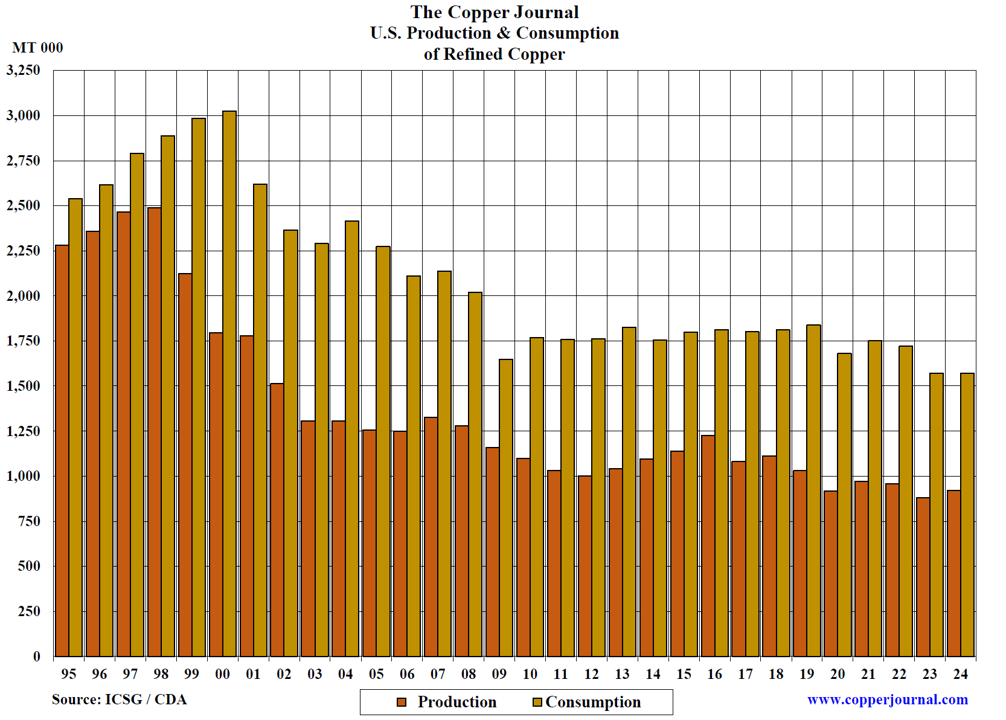
Further, in October 2024, the National Mining Association had an article titled “Copper: Powering America’s Future and Securing Our Supply Chains” further emphasizing the copper challenge and highlighting that “copper is the backbone of the future.”
Some stats / info:
- US has 48+ million tons of copper! And remember, we use about 1.8 million tons of refined copper … which means it is a diminishing resource
- Key mining states are Arizona, Nevada, Minnesota and Utah.
- A key challenge is permitting process and regulatory barriers, which can stretch “decades.” (comment – if this isn’t addressed, and it will be a combination of federal and state initiatives, then the tariff will not be enough to stimulate domestic output.)
Thoughts
Thank you to Chris and Dr. Gross for their contributions.
Earlier this week, Peter Zeihan shared observations on copper. In his video (and a transcript is also on his site, he comments that there are 4 key inputs to achieving the industrial renaissance that tariffs is supposed to support – copper, steel, aluminum, and labor.
The challenge is that increasing domestic production of all four takes time (and labor could be replaced, in some instances, with automation.)
As the price of copper increases,
- What will it do to current projects?
- What further price increases may occur (either “now” or come early next year on the more “traditional” price increase cycle)?
- What will be the impact on future construction projects? Copper is not only for the electrical element of a project. Plumbing is also heavily impacted. Will construction delays occur? Will projects be downsized to fit budgets? Will the renovation market increase?
In reality, it’s all only conjecture right now. Copper is hovering around $6.00. What, if any, is the upper limit … and there are interesting dynamics that could affect distributor sales or be share-taking strategies, rebates, in some instances commissions for distributor salespeople as well as, in some instances, manufacturer reps.
Are you looking at copper increases in a traditional “price pass-through” way or more as a sales and profitability strategy? A thought for distributors … GM$ are more important than GM%, no matter what pricing people say.


